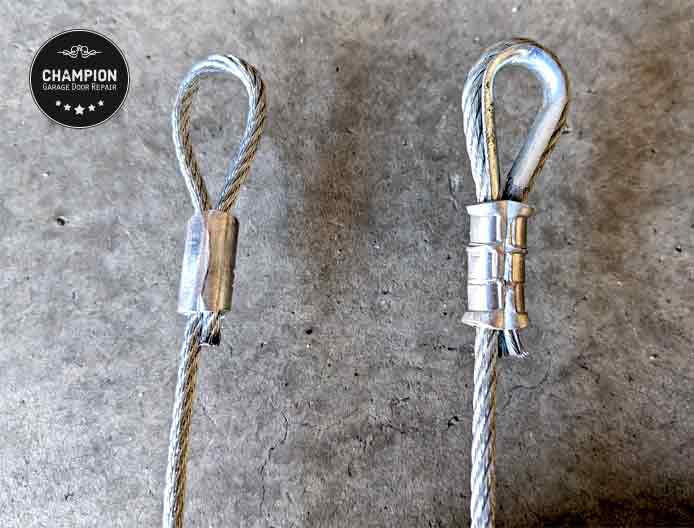Garage door cables play a critical role in torsion assemblies by transmitting torque from the pulley to the garage door. They are designed to be strong, flexible, and resilient.
Galvanized garage door cables are ideal for use in sectional overhead door systems because they are able to withstand high levels of tension and stress without breaking or becoming damaged. Additionally, the protective zinc coating helps to protect the cable from corroding or rusting, which can weaken the cable and make it more prone to failure.
The cables are typically attached to the door’s bottom brackets on one end, with the other end attached to the torsion assembly pulleys. As the pulling force is applied by the torsion springs, the cable is pulled through the pulley, creating a mechanical advantage that allows a smaller force to move a larger load.
Common types of garage door cables
There are several types of galvanized garage door cables available, each with its own characteristics and properties:
1/8″ Diameter door cable: 1/8″cable is the most common type which fits steel, insulated, light duty aluminum or light duty wood garage doors. These cables can support up to 450-pound garage doors.
5/32″ Diameter door cable: 5/32″cable fits medium to heavy duty full view and semi-custom wood garage doors. These cables can support up to 750-pound garage doors.
3/16″ Diameter door cable: 3/16″cable fits medium to heavy duty full view and fully custom wood garage doors. These cables can support up to 1500-pound garage doors.

What type of cable is right for your garage door?
The right cables for your overhead door system depend on a variety of factors, such as the type and size of pulley (or drum), the door’s overall weight, and the setting in which the cables will be used.
It’s important to note that not all cables are compatible with all lift cable drums. The cable must fit the drum’s groove correctly and be able to move freely within it without slipping or binding. The cable diameter must match the pulley’s groove size, and the cable end loop should be compatible with the bottom bracket’s anchor point.
The cable length also must be compatible with the door overall height. As a rule of thumb, you measure the height from the door’s bottom bracket anchor point to the pivot point (center of the drum), then add another 6-10 inches.
The standard cable length for 7’ high doors is 105″ long, and 117″ for 8’ high doors. High lift or rear torsion assemblies may require custom length cables to be made.
Signs that your garage door cables need to be replaced
There are several signs that a door cable may need to be replaced, including:
Fraying or wear: Fraying or wear on the cable can weaken it and increase the risk of breakage. Any fraying or wear should be inspected and the cable may need to be replaced. Frayed cables can be dangerous, as they may not be able to support the garage door’s load and can potentially break under stress.
Changes in load capacity: If the door’s weight has changed for some reason, it may be necessary to replace the cable with a stronger or larger diameter cable to ensure safe and effective operation.
Age: Door cables have a limited lifespan and will eventually need to be replaced. The lifespan of a cable depends on factors such as the door weight, frequency of use, and environmental factors. A cable should be replaced if it is past its recommended lifespan.
Visible wear and tear: Cables that show visible signs of wear and tear, with individual strands of wire beginning to unravel, as well as cables that have been exposed to moisture, water, or chemicals, it may show signs of corrosion or rust that can weaken the cable and increase the risk of breakage. Rusted cables are very common in coastal environments, where the salty air from the beach corrodes metal architectural systems.
Kinking or distortion: If the cable has been subject to excessive stress or pressure, it may become kinked or distorted, which can weaken the cable and increase the risk of breakage.
Symptoms of a broken or misplaced cable
When a cable is broken or came undone, there are several symptoms that may be noticeable. These can include:
Loss of tension or slackness: When a cable breaks, the tension that was previously present is lost, and the cable will become slack. This can cause the door, which is being supported by the torsion assembly, to come crashing down. If only one cable is broken or came out of its position, this will cause the garage door to come off the tracks or be skewed to the broken cable side (since the torque distribution from the springs is no longer even).
Irregular movement or jamming: A broken cable can cause irregular movement or jamming of the garage door when it opens or closes. This can make it difficult or impossible to lift or move the garage door smoothly.
Visible damage or wear: If a cable is broken, it may be visibly damaged or worn, with frayed or broken strands of wire or visible signs of corrosion.
Uneven wear or stretching: Over time, cables can stretch or wear unevenly, which can weaken the cable and increase the risk of breakage. This is especially common with heavy duty garage doors like custom wood and full view. If a cable is showing signs of uneven wear or stretching, it should be inspected and replaced immediately.
What to do if your cable has snapped?
If any of the above signs or symptoms are noticed, it is important to stop using the garage door and inspect the cable for wear or damage. A broken cable can be extremely dangerous and so does the cables repair process, therefore, should be replaced by a licensed garage door repair contractor only.








